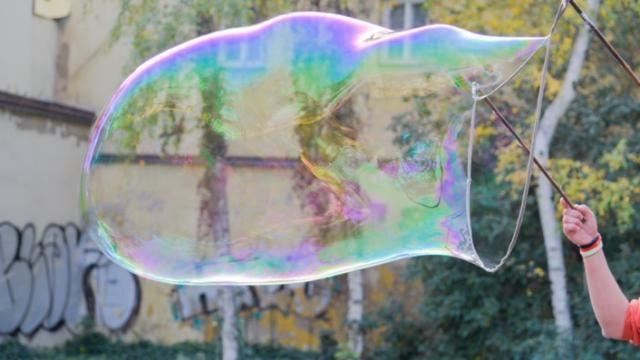We’ve all delighted in the simple joy of blowing bubbles, but most of us never stop to think about the underlying physics. Now French physicists have devised a mathematical model that precisely predicts just how hard you need to blow to produce a perfectly formed bubble.
Laurent Courbin and Pascal Panizza of the French National Center for Scientific Research and the University of Rennes were inspired by the sight of children blowing bubbles in a nearby park. They realised that this was actually a poorly understood everyday phenomenon — namely, the exact mechanism by which bubbles form when jets of air hit a soap film. They describe the results of their investigation in a new paper in Physical Review Letters.
Scientists have been studying bubbles and soap films for centuries, ever since the early 1800s, when Belgian physicist Joseph Plateau first laid out four basic laws describing the structure of such films in his studies of surface tension. Surface tension is the reason bubbles naturally want to be round: it’s the shape with the least surface for any volume. In general, the more surface area there is, the more energy it takes to maintain a given shape. Bubbles are lazy that way.
But bubbles in a foam “coarsen” over time: gravity pulls the liquid downward, thinning the walls, and smaller bubbles gradually get absorbed by larger ones. Courbin and Panizza needed longer-lasting soap films for their experiments. Their bubble-blowing apparatus was inspired by earlier work by Maarten Rutgers (now a physicist at Asylum Research), who once constructed a four-storey flowing soap film in the Carnegie Science Center in Pittsburgh.
It involved hanging two weighted nylon wires (like fishing line) vertically from a single point about three feet high. Then they dripped a simple soapy solution (usually one or two parts Dawn dish soap detergent to 100 parts tap water) onto the top of the wires. The soap dribbled down and the wires stuck together.
When they gently pulled the wires apart, they produced a nice thin soap film that constantly flowed, because the liquid collected at the bottom and was pumped back up to the top — unlike the soap films in a standard bubble wand, which are stationary. This also let the scientists control the thickness of the film and how fast it flowed. After that, it was just a matter of blowing on the films with jets of gas produced by a handy nozzle. They captured the results with a high-speed camera:
They found that bubbles only form above a certain speed threshold for air velocity. As Emily Conover writes at Physics Focus:
At low gas jet speeds, only a small dimple appeared in the soap film. The dimple became deeper as the team increased the jet’s speed, until bubbles finally formed. The phenomenon, the researchers found, can be explained as a contest between the pressure the gas jet exerts on the film and the surface tension of the film, which resists any increase in curvature. Bubbles form when the jet’s pressure is large enough to deform the film into a hemispheric dimple of the same width as the jet. At that point, the film has reached its maximum curvature, and the bubble can fill with gas and float away.
That threshold speed varies with the width of the jet, not the thickness of the soap film. Wider jets have a lower speed threshold and produce larger bubbles than narrower ones. (If the jet is wider than the soap film, the width of the bubble wand will determine the threshold speed.) The French physicists repeated the experiment with a simple bubble wand, just to demonstrate that these principles hold for actual everyday bubble-blowing.
This isn’t just child’s play. If you want to avoid bubbles forming in glassmaking and other industrial processes, for instance, having a better understanding of the underlying physics is very helpful. Bubble physics is also relevant to building lab-on-a-chip bubble logic devices, and artificial viruses for vaccines. Mostly, though, “This paper is really about explaining an everyday-life experiment,” Courbin told Physics Focus.
Top image: Kitty Samma/Shutterstock
